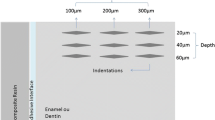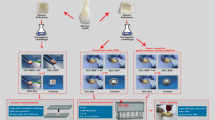Abstract
Objectives
To evaluate the effect of a tin-containing fluoride (Sn/F) mouth rinse on microtensile bond strength (μTBS) between resin composite and erosively demineralised dentin.
Materials and methods
Dentin of 120 human molars was erosively demineralised using a 10-day cyclic de- and remineralisation model. For 40 molars, the model comprised erosive demineralisation only; for another 40, the model included treatment with a NaF solution; and for yet another 40, the model included treatment with a Sn/F mouth rinse. In half of these molars (n = 20), the demineralised organic matrix was continuously removed by collagenase. Silicon carbide paper-ground, non-erosively demineralised molars served as control (n = 20). Subsequently, μTBS of Clearfil SE/Filtek Z250 to the dentin was measured, and failure mode was determined. Additionally, surfaces were evaluated using SEM and EDX.
Results
Compared to the non-erosively demineralised control, erosive demineralisation resulted in significantly lower μTBS regardless of the removal of demineralised organic matrix. Treatment with NaF increased μTBS, but the level of μTBS obtained by the non-erosively demineralised control was only reached when the demineralised organic matrix had been removed. The Sn/F mouth rinse together with removal of demineralised organic matrix led to significantly higher µTBS than did the non-erosively demineralised control. The Sn/F mouth rinse yielded higher μTBS than did the NaF solution.
Conclusions
Treatment of erosively demineralised dentin with a NaF solution or a Sn/F mouth rinse increased the bond strength of resin composite.
Clinical relevance
Bond strength of resin composite to eroded dentin was not negatively influenced by treatment with a tin-containing fluoride mouth rinse.



Similar content being viewed by others
References
Rølla G (1988) On the role of calcium fluoride in the cariostatic mechanism of fluoride. Acta Odontol Scand 46:341–345
Wiegand A, Magalhães AC, Attin T (2010) Is titanium tetrafluoride (TiF4) effective to prevent carious and erosive lesions? A review of the literature. Oral Health Prev Dent 8:159–164
Ganss C, Schlueter N, Hardt M, Schattenberg P, Klimek J (2008) Effect of fluoride compounds on enamel erosion in vitro: a comparison of amine, sodium and stannous fluoride. Caries Res 42:2–7
Ganss C, Lussi A, Sommer N, Klimek J, Schlueter N (2010) Efficacy of fluoride compounds and stannous chloride as erosion inhibitors in dentine. Caries Res 44:248–252
Ganss C, Neutard L, von Hinckeldey J, Klimek J, Schlueter N (2010) Efficacy of a tin/fluoride rinse: a randomized in situ trial on erosion. J Dent Res 89:1214–1218
Cooley WE (1961) Reactions of tin (II) and fluoride ions with etched enamel. J Dent Res 40:1199–1210
Krutchkoff DJ, Jordan TH, Wei SH, Nordquist WD (1972) Surface characterization of the stannous fluoride-enamel interaction. Arch Oral Biol 17:923–930
Babcock FD, King JC, Jordan TH (1978) The reaction of stannous fluoride and hydroxyapatite. J Dent Res 57:933–938
Ganss C, Hardt M, Lussi A, Cocks AK, Klimek J, Schlueter N (2010) Mechanism of action of tin-containing fluoride solutions as anti-erosive agents in dentine: an in vitro tin-uptake, tissue loss, and scanning electron microscopy study. Eur J Oral Sci 118:376–384
Bartlett D, Sundaram G (2006) An up to 3-year randomized clinical study comparing indirect and direct resin composites used to restore worn posterior teeth. Int J Prosthodont 19:613–617
Gerrard WA, Winter PJ (1986) Evaluation of toothpastes by their ability to assist rehardening of enamel in vitro. Caries Res 20:209–216
Brunner E, Munzel U (2002) Nichtparametrische Datenanalyse (in German). Springer, Heidelberg
Schlueter N, Klimek J, Ganss C (2009) Efficacy of an experimental tin-F-containing solution in erosive tissue loss in enamel and dentine in situ. Caries Res 43:415–421
Lussi A, Schlueter N, Rakhmatullina E, Ganss C (2011) Dental erosion: an overview with emphasis on chemical and histopathological aspects. Caries Res 45(Suppl 1):2–12
Schlueter N, Neutard L, von Hinckeldey J, Klimek J, Ganss C (2010) Tin and fluoride as anti-erosive agents in enamel and dentine in vitro. Acta Odontol Scand 68:180–184
Vaidyanathan TK, Vaidyanathan J (2009) Recent advances in the theory and mechanism of adhesive resin bonding to dentin: a critical review. J Biomed Mater Res B Appl Biomater 88:558–578
Peumans M, De Munck J, Van Landuyt KL, Poitevin A, Lambrechts P, Van Meerbeek B (2010) Eight-year clinical evaluation of a 2-step self-etch adhesive with and without selective enamel etching. Dent Mater 26:1176–1184
Scherrer SS, Cesar PF, Swain MV (2010) Direct comparison of the bond strength results of the different test methods: a critical literature review. Dent Mater 26:e78–e93
Yoshida Y, Nagakane K, Fukuda R, Nakayama Y, Okazaki M, Shintani H, Inoue S, Tagawa Y, Suzuki K, De Munck J, Van Meerbeek B (2004) Comparative study on adhesive performance of functional monomers. J Dent Res 83:454–458
Fukegawa D, Hayakawa S, Yoshida Y, Suzuki K, Osaka A, Van Meerbeek B (2006) Chemical interaction of phosphoric acid ester with hydroxyapatite. J Dent Res 85:941–944
Vaidyanathan J, Vaidyanathan TK, Kerrigan JE (2007) Evaluation of intermolecular interactions of self-etch dentin adhesive primer molecules with type 1 collagen: computer modeling and in vitro binding analysis. Acta Biomater 3:705–714
Scott JE, Thomlinson AM (1998) The structure of interfibrillar proteoglycan bridges (shape modules) in extracellular matrix of fibrous connective tissues and their stability in various chemical environments. J Anat 192:391–405
Mazzoni A, Pashley DH, Ruggeri A Jr, Vita F, Falconi M, Di Lenarda R, Breschi L (2008) Adhesion to chondroitinase ABC treated dentin. J Biomed Mater Res B Appl Biomater 86:228–236
Helmerhorst EJ, Oppenheim FG (2007) Saliva: a dynamic proteome. J Dent Res 86:680–693
Schlueter N, Hardt M, Klimek J, Ganss C (2010) Influence of the digestive enzymes trypsin and pepsin in vitro on the progression of erosion in dentine. Arch Oral Biol 55:294–299
Acknowledgements
The authors would like to thank 3 M ESPE, Germany and Kuraray Europe, Germany for providing the materials needed. Furthermore, we thank S. Hayoz and Prof. Dr. J. Hüsler, Institute of Mathematical Statistics and Actuarial Science, University of Bern, for statistical analyses.
Conflicts of interest
The authors declare no conflicts of interest, real or perceived, financial or non-financial.
Author information
Authors and Affiliations
Corresponding author
Electronic supplementary material
Below is the link to the electronic supplementary material.
ESM 1
(JPEG 18 kb)
Rights and permissions
About this article
Cite this article
Flury, S., Koch, T., Peutzfeldt, A. et al. The effect of a tin-containing fluoride mouth rinse on the bond between resin composite and erosively demineralised dentin. Clin Oral Invest 17, 217–225 (2013). https://doi.org/10.1007/s00784-012-0697-1
Received:
Accepted:
Published:
Issue Date:
DOI: https://doi.org/10.1007/s00784-012-0697-1




